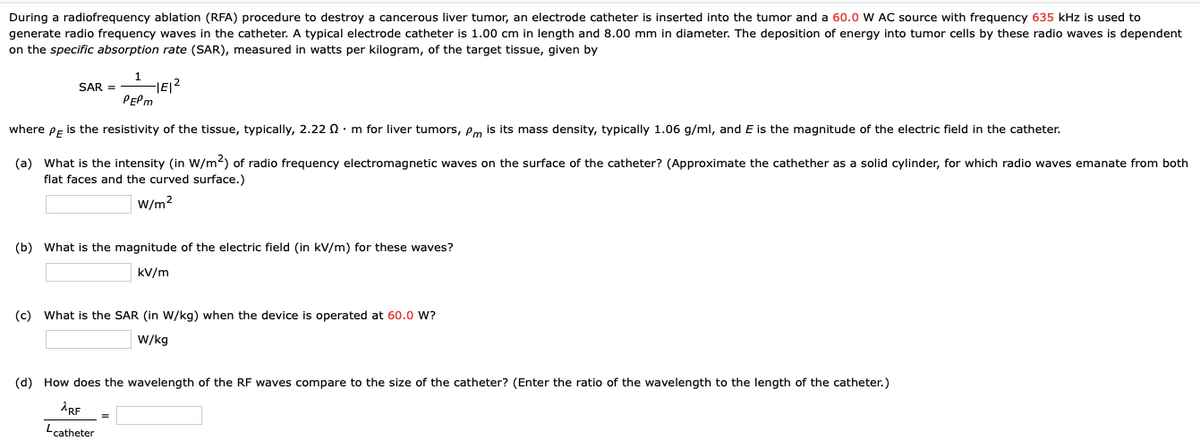During a radiofrequency ablation (RFA) procedure to destroy a cancerous liver tumor, an electrode catheter is inserted into the tumor and a 60.0 W AC source with frequency 635 kHz is used to generate radio frequency waves in the catheter. A typical electrode catheter is 1.00 cm in length and 8.00 mm in diameter. The deposition of energy into tumor cells by these radio waves is dependent on the specific absorption rate (SAR), measured in watts per kilogram, of the target tissue, given by 1 SAR = PEPM where Pe is the resistivity of the tissue, typically, 2.22 0· m for liver tumors, pm is its mass density, typically 1.06 g/ml, and E is the magnitude of the electric field in the catheter. (a) What is the intensity (in Ww/m2) of radio frequency electromagnetic waves on the surface of the catheter? (Approximate the cathether as a solid cylinder, for which radio waves emanate from both flat faces and the curved surface.) W/m2 (b) What is the magnitude of the electric field (in kV/m) for these waves? kV/m (c) What is the SAR (in W/kg) when the device is operated at 60.0 W? W/kg
During a radiofrequency ablation (RFA) procedure to destroy a cancerous liver tumor, an electrode catheter is inserted into the tumor and a 60.0 W AC source with frequency 635 kHz is used to generate radio frequency waves in the catheter. A typical electrode catheter is 1.00 cm in length and 8.00 mm in diameter. The deposition of energy into tumor cells by these radio waves is dependent on the specific absorption rate (SAR), measured in watts per kilogram, of the target tissue, given by 1 SAR = PEPM where Pe is the resistivity of the tissue, typically, 2.22 0· m for liver tumors, pm is its mass density, typically 1.06 g/ml, and E is the magnitude of the electric field in the catheter. (a) What is the intensity (in Ww/m2) of radio frequency electromagnetic waves on the surface of the catheter? (Approximate the cathether as a solid cylinder, for which radio waves emanate from both flat faces and the curved surface.) W/m2 (b) What is the magnitude of the electric field (in kV/m) for these waves? kV/m (c) What is the SAR (in W/kg) when the device is operated at 60.0 W? W/kg
Physics for Scientists and Engineers: Foundations and Connections
1st Edition
ISBN:9781133939146
Author:Katz, Debora M.
Publisher:Katz, Debora M.
Chapter33: Inductors And Ac Circuits
Section: Chapter Questions
Problem 84PQ
Related questions
Question
Please show work

Transcribed Image Text:During a radiofrequency ablation (RFA) procedure to destroy a cancerous liver tumor, an electrode catheter is inserted into the tumor and a 60.0 W AC source with frequency 635 kHz is used to
generate radio frequency waves in the catheter. A typical electrode catheter is 1.00 cm in length and 8.00 mm in diameter. The deposition of energy into tumor cells by these radio waves is dependent
on the specific absorption rate (SAR), measured in watts per kilogram, of the target tissue, given by
1
SAR =
IE/2
PEPM
where Pe is the resistivity of the tissue, typically, 2.22 Q : m for liver tumors, em is its mass density, typically 1.06 g/ml, and E is the magnitude of the electric field in the catheter.
(a) What is the intensity (in W/m2) of radio frequency electromagnetic waves on the surface of the catheter? (Approximate the cathether as a solid cylinder, for which radio waves emanate from both
flat faces and the curved surface.)
W/m2
(b) What is the magnitude of the electric field (in kV/m) for these waves?
kV/m
(c)
What is the SAR (in W/kg) when the device is operated at 60.0 W?
W/kg
(d) How does the wavelength of the RF waves compare to the size of the catheter? (Enter the ratio of the wavelength to the length of the catheter.)
"catheter
Expert Solution
This question has been solved!
Explore an expertly crafted, step-by-step solution for a thorough understanding of key concepts.
This is a popular solution!
Trending now
This is a popular solution!
Step by step
Solved in 5 steps

Knowledge Booster
Learn more about
Need a deep-dive on the concept behind this application? Look no further. Learn more about this topic, physics and related others by exploring similar questions and additional content below.Recommended textbooks for you

Physics for Scientists and Engineers: Foundations…
Physics
ISBN:
9781133939146
Author:
Katz, Debora M.
Publisher:
Cengage Learning


Physics for Scientists and Engineers: Foundations…
Physics
ISBN:
9781133939146
Author:
Katz, Debora M.
Publisher:
Cengage Learning
